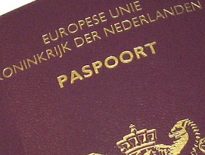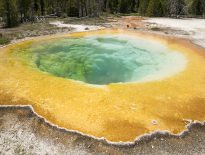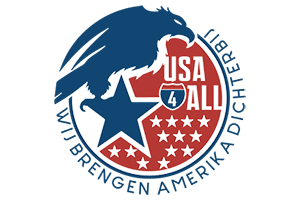
13 strepen en 50 sterren
De Amerikaanse vlag heeft 13 strepen en 50 sterren. De 13 strepen staan voor de oorspronkelijke 13 staten die te samen middels de onafhankelijkheidsverklaring zich losmaakte van de Engelsen. Deze 13 staten vormden tezamen de Verenigde Staten van Amerika. De 50 sterren staan voor de huidige 50 staten die tezamen de Verenigde Staten vormen. Op 14 juni In 1777 werd het ontwerp van de Stars and Stripes aangenomen door het congres van de V.S. als nationale vlag.
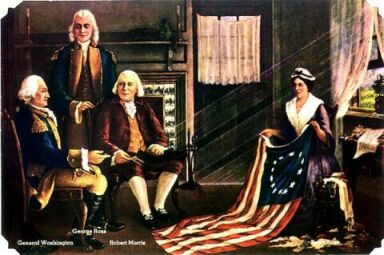 Ontstaan
Ontstaan
Betsy Ross, een naaister uit Philadelphia, wordt verantwoordelijk gehouden voor het ontstaan van de Amerikaanse vlag. Haar ontwerp zou uiteindelijk geleid hebben tot de vlag zoals hij nu is. In geen van de journaals of dagboeken en geschriften van het Continental Congress van Washington is hier echter tot op heden iets over terug te vinden.
Het resultaat
De 1e vlag heeft 13 sterren, en werd de officiële vlag van de Verenigde Staten op 14 juni 1777. De enige president onder deze vlag was George Washington (1789-1797). Deze vlag bleef aan voor een periode van 18 jaar. In de jaren die er op volgden werd voor elke bijkomende staat een ster toegevoegd. Men heeft er even aan gedacht om voor elke staat, een ster en een streep toe te voegen. Maar dat was erg onlogisch.
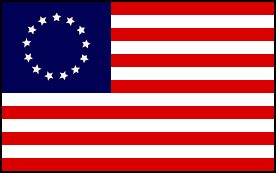 De 1e officiële Amerikaanse vlag
De 1e officiële Amerikaanse vlag
Als u geïnteresseerd bent in het verdere verloop van het ontstaan van de Amerikaanse vlag tot wat het nu is, verwijzen wij u graag naar de site met de historie van deze driekleur. Klik hier.
Pledge of Allegiance
Op scholen is het de gewoonte dat kinderen ’s morgens voor de lessen beginnen trouw zweren aan de vlag. Deze “Pledge of Allegiance” hebben we hieronder op de website geplaatst. Het is een oude traditie waarin de kinderen zweren de waarden en normen van de “Founding Fathers” te handhaven.
| Engelstalig: | Nederlandstalig: |
| To the Flag Of the United States of America And to the Republic For Which it Stands One Nation Under God, Indivisible, With Liberty And Justice For All |
Ik beloof trouw Aan de vlag van de Verenigde Staten van Amerika En aan de Republiek Waarvoor zij staat Eén land onder God, Ondeelbaar, Met vrijheid en rechtvaardigheid Voor allen |
Betekenis van het vouwen van de Amerikaanse vlag
Betsy Ross
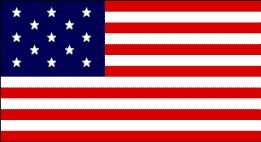 Elizabeth Griscom Ross (1752-1836), was a Philadelphia seamstress, married to John Ross, an upholsterer who was killed in a munitions explosion in 1776. She kept the upholstery shop going and lived on Arch Street, not too far from the State House on Chestnut, where history was being made almost every day. According to most historians, she has been incorrectly credited with designing the first Stars and Stripes. The story has enormous popularity, yet the facts do not substantiate it. Lets begin with the legend itself.
Elizabeth Griscom Ross (1752-1836), was a Philadelphia seamstress, married to John Ross, an upholsterer who was killed in a munitions explosion in 1776. She kept the upholstery shop going and lived on Arch Street, not too far from the State House on Chestnut, where history was being made almost every day. According to most historians, she has been incorrectly credited with designing the first Stars and Stripes. The story has enormous popularity, yet the facts do not substantiate it. Lets begin with the legend itself.
George Washington was a frequent visitor to the home of Mrs. Ross before receiving command of the army. She embroidered his shirt ruffles and did many other things for him. He knew her skill with a needle. Now the General of the Continental Army, George Washington appeared on Mrs. Ross’s dooorstep around the first of June, 1776, with two representatives of Congress, Colonel Ross and Robert Morris. They asked that she make a flag according to a rough drawing they carried with them. At Mrs.Ross’s suggestion, Washington redrew the flag design in pencil in her back parlor to employ stars of five points instead of six. (“Her version” of the flag for the new republic was not used until six years later.)
This account of the creation of our first flag was first brought to light in 1870 by one of her grandsons, William J. Canby, at a meeting of the Historical Society of Pennsylvania. This took place 94 years after the event supposedly took place! Mr. Canby was a boy of eleven years when Mrs. Ross died in his home.
In the many years since the story was told, numerous historians have conducted vigorous searches into extant government records, personal diaries,and writings of Washington and his contemporaries and none of them have been able to verify the claims of Canby. One verifiable fact is this; the minutes of the State Navy Board of Pennsylvania for May 29, 1777, say in part “An order on William Webb to Elizabeth Ross for fourteen pounds twelve shillings, and two pence, for making ship’s colours, put into Richards store”. The minutes show that Elizabeth Ross made ship’s colors for Pennsylvania state ships. Some of the facts, among others, that have been discovered by this research that cast doubt on Canby’s claim are these; He asserted that the stars and stripes were in common if not general use soon after the signing of the Declaration of Independence, nearly a year before the resolution of Congress proclaiming the flag.
There is no record of the flag being discussed or of a committee being appointed for the design of the flag in either the Journals of the Continental Congress or the diaries and writings of Washington around this time. Meetings with Colonel Ross and Robert Morris cannot be documented. Further, it is illogical to assume that Washington was present at the alleged meeting with Betsy Ross on the design of the flag when it is known that he wanted a national standard made for the use of the army in 1779.
But I think that the question that begs to be asked is; Why have so many generations of Americans come to accept this legend as fact? After Canby’s death, a book written by his brother George Canby and nephew Lloyd Balderson was published in 1909. The book, The Evolution of the American Flag, presented in more detail the claims for Betsy Ross made by William Canby in 1870. Among other things, the authors describe the formation of the Betsy Ross Memorial Association, and reproduced a painting by Charles H. Weisgerber depicting the alleged meeting of the committee of Congress with Betsy Ross.
The picture, entitled Birth of Our Nations Flag, is actually a composite portrait made up of from pictures of her granddaughters and other decendants. The artist took liberties with history by painting the stars in the flag in a circle. This painting, incidently, stirred a great deal of public interest in the subject when it was first exibited, at the Columbian Exposition in Chicago in 1893. Following this, money to purchase the Betsy Ross house in Philadelphia was raised by selling ten-cent subscriptions to the American Flag House and Betsy Ross Memorial Association, incorporated in 1898. Each contributor received a certificate of membership that included a picture of the house, her grave in Mt. Moriah Cemetery in Philadelphia, and a color reproduction of the Weisberger painting. This campaign gave the legend wide publicity and the Weisberger painting was reproduced in school history textbooks thoughout the United States!
In the days of Betsy Ross we did not have the benefit of a frenetic press corps to witness, probe, and record the events of the day. Careful historians do not accept the legend and neither should we. At the same time, there often seems to be a wistful regret, best expressed, perhaps, by President Woodrow Wilson when asked his opinion of the story. He replied, “Would that it were true!”



